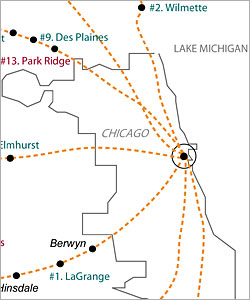“The commuter rail station is to a suburb what the airport is to a city—the gateway to the world,” says Joseph Schwieterman, a DePaul University expert on public policy and transportation. And according to a study that Schwieterman’s team unveils today, some of the gateways in Chicago suburbs are truly first-class: pleasant, comfortable stations set amid walkable, useful village downtowns and furnished with enough nice touches that they “dignify the experience of commuting by train,” as he puts it.
LaGrange tops the list of train-friendly towns, according to the report from the Chaddick Institute for Metropolitan Development at DePaul. To get to their clean, well-served La Grange Road train station, commuters walk, bike or drive through a shopping and dining area that Chicago highlighted as the suburbs’ best in 2009. That experience has all the earmarks of what Schwieterman calls “a transit-friendly community.”
Also landing in the top 5 train towns were Wilmette, Arlington Heights, Glenview and Elmhurst. The map above shows all 20 of the best train towns; more information on the rankings is at the study’s website.
Two towns you’d expect to be right at the top, Evanston and Oak Park, were excluded from the study because “they’re city-suburbs,” Schwieterman says. “Evanston doesn’t even like to be called a suburb.’ Both towns enjoy a Chicago level of transit service, with both CTA and Metra working their streets. The DePaul study was expressly about suburbs that rely on commuter rail service. (For towns served by multiple stations, only the central downtown station was considered.)
The top train towns are, for the most part, older suburbs that sprang up around train lines in the years before cars were popular, so that their stations are set in a central spot, with retail and housing right nearby. “That’s fairly tightly clustered, so it maximizes the population that can walk or bike—have a relatively car-free commute,” Schwieterman explains. They have what he describes as “deep community connectivity” to train commuting.
That helps explain the dearth of southern suburbs among the top scorers: most of their development came during the car-centric era; their train stations may be inaccessible on foot, or little used. Even an old 19th-century golf resort, Flossmoor, with a station it its center, didn’t fare well because its downtown has little to offer commuters as they walk by. (On this one, Schwieterman should know: he’s been commuting to the city from Flossmoor by train for 21 years.)
But the top train towns have much more than history on their side. The Chaddick team began with data on 250 suburbs, covering the frequency of train service, the number of riders who use a station, and the proportion that walks or bikes to the station over driving there.
For the top 25 scorers, the next step entailed a visit to the station by a three-person team that took a detailed look. They evaluated the nighttime light level in the parking lot; the presence or absence of train schedules, clocks and community information inside the station; and whether you could see retail storefronts from the train platform. “Do you get off the train and say, ‘let’s go there’?” Schwieterman asked. The teams even did a white-glove test, checking for dust and grime on train stations’ windowsills. Stations scored for having power outlets, free wifi, and a place to buy coffee. The quality of parking lots figured in, but not the size—the team didn’t want to reward a town for blanketing the space around the station with parking, which lessens the pedestrian’s connection to the village center.
Clearly, a spot near the top of the list means a town has an ingrained train-commuting culture. People who are looking for suburban housing and want what Schwieterman describes as “greater balance in their transportation” should consider looking at these places.
Overall, the Metra commuter rail system scores well in Schiweterman’s book. “Despite this last fare increase, they have exemplary ontime performance and convenient downtown stations,” he says. “Most people can do a one-leg commute, not a two-leg, where you have to take two trains or [modes of transportation.” He lauds Metra’s recent announcement that upgraded passenger cars will have power outlets installed so riders can charge cellphones and laptops. Previous studies by his group found that 40 percent of riders are using technology aboard.
Together, the quality of the rail lines’ service and many communities' high level of commitment to their stations and stations’ surroundings mean Chicago is “the only place in the middle of America where you can comfortably live without heavy reliance on a car,” Schwieterman says. “City neighborhoods get so much attention for being transit-friendly, but some suburban communities have public transportation that are really underappreciated.”



